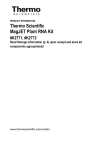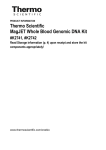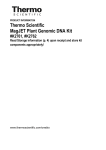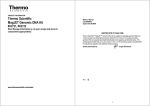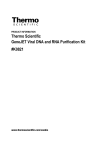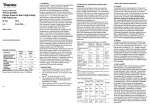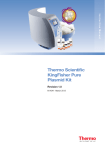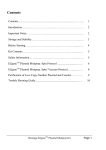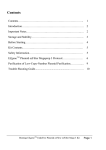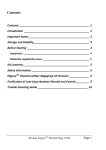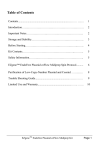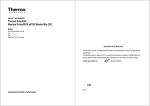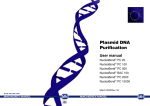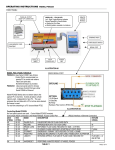Download CloneJET™ PCR Cloning Kit
Transcript
PRODUCT INFORMATION Thermo Scientific MagJET Plasmid DNA Kit #K2791, #K2792 Read Storage information (p. 4) upon receipt and store kit components appropriately! www.thermoscientific.com/onebio #K2791, #K2792 Lot 00000000 Exp. 00.0000 CERTIFICATE OF ANALYSIS Thermo Scientific™ MagJET™ Plasmid DNA Kit is qualified by isolating high copy plasmid DNA from 0.5-5 mL of overnight E. coli culture grown in LB or rich growth (OD600 = 2-6). The quality of isolated DNA is evaluated spectrophotometrically and by agarose gel electrophoresis. The purified DNA has an A260/A280 ratio of 1.8±0.2. Quality authorized by: Rev.1 Jurgita Žilinskienė V 2 CONTENTS page COMPONENTS OF THE KIT ....................................................................................................4 STORAGE .................................................................................................................................4 DESCRIPTION ..........................................................................................................................4 PRINCIPLE ............................................................................................................................... 4 IMPORTANT NOTES ................................................................................................................5 ADDITIONAL MATERIALS AND EQUIPMENT REQUIRED......................................................5 PROTOCOL SELECTION GUIDE ............................................................................................. 7 PLASMID DNA PURIFICATION PROTOCOLS AND PIPETTING INSTRUCTIONS .................8 Protocol A. Instructions for plasmid DNA purification using KingFisher Flex 96 and Microtiter deep well 96 plates ...............................................................................................................8 Protocol B. Instructions for plasmid DNA purification using KingFisher Duo with 12-pin magnet head and Microtiter deep well 96 plate ................................................................... 10 Protocol C. Instructions for manual plasmid DNA purification.............................................. 12 TROUBLESHOOTING ............................................................................................................ 14 SAFETY INFORMATION ........................................................................................................ 15 3 COMPONENTS OF THE KIT MagJET Plasmid DNA Kit RNase A Resuspension Solution for MagJET Plasmid DNA Kit Lysis Buffer for MagJET Plasmid DNA Kit Neutralization Solution for MagJET Plasmid DNA Kit MagJET Magnetic Beads Wash Buffer 1 (conc.) for Plasmid DNA Kit Wash Buffer 2 (conc.) for Plasmid DNA Kit Elution Buffer for MagJET Plasmid DNA Kit #K2791 96 preps 0.28 mL 25 mL 25 mL 25 mL 2 × 1.4 mL 110 mL 60 mL 18 mL #K2792 384 preps 1.0 mL 90 mL 90 mL 90 mL 1 × 10.6 mL 3 × 110 mL 3 × 60 mL 45 mL STORAGE RNase A solution is stable at room temperature as long as the vial remains sealed. After being opened, it should be stored at -20°C. MagJET Magnetic Beads should be stored at 4°C. Other components of the kit should be stored at room temperature (15-25°C). DESCRIPTION The MagJET Plasmid DNA Kit is designed for fast and efficient purification of plasmid DNA (up to 4-5 µg/mL) or high copy plasmid DNA from overnight E. coli culture. The kit utilizes paramagnetic bead technology enabling high yields and robust performance. High binding capacity, uniform particle size, and rapid magnetic response of MagJET Magnetic Beads makes the technology ideal for high throughput automatic nucleic acid purification, as well as for manual purification for low sample throughput users. The resulting high quality DNA is free of proteins, nucleases and other contaminants or inhibitors. Purified plasmid DNA can be used in a wide range of downstream applications such as PCR, qPCR and other enzymatic reactions. PRINCIPLE The MagJET Plasmid DNA Kit uses the highly efficient MagJET magnetic particle-based technology for nucleic acid purification. The whole nucleic acid isolation process combines simple steps of sample lysis, DNA binding to the magnetic beads, washing and elution. Pelleted bacterial cells are resuspended and subjected to SDS/alkaline lysis to liberate plasmid DNA. The resulting lysate is neutralized, allowing denatured plasmid DNA to re-anneal while cell debris such as proteins, chromosomal DNA and SDS precipitate out of solution. The resulting precipitate is pelleted by centrifugation. Purification protocols optimized for automated KingFisher instruments utilize a high throughput magnetic bead transfer technique where magnetic beads are transferred through different reagent plates containing lysis, binding, washing and elution reagents. Alternatively, a protocol is provided where buffers and other reagents are transferred in each of the protocol steps, while magnetic beads remain captured on the wall of the tube with the help of a magnetic rack. This allows the kit to be used in various throughput applications using a magnetic rack and manual or automated pipetting equipment. 4 IMPORTANT NOTES Add the provided RNase A solution to the Resuspension Solution and mix thoroughly. After the addition of RNase A, the Resuspension Solution is stable for 6 months when stored at 4°C. For prolonged storage, portion the Resuspension Solution into an appropriate number of aliquots and supplement one aliquot with 10 µL of RNase A per 1 mL of Resuspension Solution. Store the remaining RNase A at -20°C. Additional working solutions can be prepared by supplementing an aliquot of the Resuspension Solution with RNase A. Note: Addition of RNase A to the Resuspension Solution can be omitted if the purified DNA will be used for in vitro transcription applications. Add the indicated volume of isopropanol and ethanol (96-100%) to Wash Buffer 1 (concentrated) and ethanol (96-100%) to Wash Buffer 2 (concentrated) prior to first use: #K2791 (96 preps) Wash Buffer 1 Wash Buffer 2 Concentrated buffer Isopropanol Ethanol (96-100%) Total volume: #K2792 (384 preps) Wash Buffer 1 Wash Buffer 2 110 mL 60 mL 3 × 110 mL 3 × 60 mL 55 mL - 3 × 55 mL - 55 mL 162 mL 3 × 55 mL 3 × 162 mL 220 mL 222 mL 3 × 220 mL 222 mL After preparing each solution, mark the bottle to indicate that this step has been completed. Check all solutions in the kit for any salt precipitation before each use. Re-dissolve any precipitates by warming the solution at 37°C, and then equilibrate to room temperature (20 ± 5°C). Do not vigorously shake the Lysis Solution. Wear gloves when handling the Lysis Buffer and Wash Buffer 1 as these reagents contain irritants (see page 15 for SAFETY INFORMATION). ADDITIONAL MATERIALS AND EQUIPMENT REQUIRED Pipettes and pipette tips. 1.5-10 mL plastic tubes. Vortex. Disposable gloves. 100% isopropanol, molecular biology grade. 96-100% ethanol, molecular biology grade. Automatic magnetic particle processor and consumables. For manual protocol, acquire magnetic particle processing rack. Thermomixer. Centrifuge capable of ≥ 20,000 x g. Centrifuge capable of 4,000 x g with swinging bucket rotor for 96 well plates. 5 Bacterial strains High quality plasmid DNA can be obtained from various E.coli strains including DH10B, DH5α, JM109, JM107 or TOP10, as well as endA+ strains. Culture Medium The MagJET Plasmid DNA Kit protocols are optimized for use with bacterial cultures grown in Luria-Bertani (LB) or rich medium. The use of rich growth medium, such as Super Broth (SB), 2XYT, may give higher yields. Bacterial Culture Growth Dispense 0.5 to 1.5 mL of LB culture medium containing appropriate antibiotic into the deep- well of the 96-well culture plate (2 mL). Choose a single, well-isolated colony from a fresh agar plate to inoculate each well. The inoculated cultures should be incubated overnight (16 hours at 37°C) with agitation (250 × rpm). Rich growth medium is recommended when maximum cell biomass is required. An OD600 of 2.0–6.0 for high-copy number plasmids ensures that bacteria have reached the optimal cell density for harvesting and plasmid DNA isolation. Using cultures that have OD600 readings >6.0 may lead to incomplete bacterial cell lysis and contamination of the isolated plasmid DNA by genomic DNA and other impurities. Harvest the cells by centrifugation at 2500 × g for 10 min. Discard the supernatant. The bacterial pellet can be used immediately or stored at -20°C. 6 PROTOCOL SELECTION GUIDE The MagJET Plasmid DNA Kit provides optimized protocols for plasmid DNA purification from different amounts of starting material (0.5-5 mL). The Kit is compatible with automated and manual sample processing, allowing low- to high-throughput nucleic acid purification workflow. The following selection guide summarizes available protocols depending on starting sample volume, amount of samples, throughput and sample processing type. Automation protocols are optimized for KingFisher Flex and KingFisher Duo instruments. Note. Transfer the Plasmid_DNA_Flex protocol file to the KingFisher Flex or Plasmid_DNA _Duo protocol file to the Kingfisher Duo instrument before first use. The instructions for transferring the protocol can be found in Chapter 4: “Using the software” in the BindIt Software for KingFisher Instruments version 3.2 User Manual. The protocol files for MagJET Plasmid DNA Kit can be found on product web page on www.thermoscientific.com/onebio. Manual processing 0.5-5 mL KingFisher Duo Instrument Overnight E. coli culture KingFisher Flex Instrument Sample type Sample volume Throughput per run Protocol selection guide: MagJET purification protocol 96 ● - - Protocol A page 8 12 - ● - Protocol B page 10 variable - - ● Protocol C page 12 7 Page PLASMID DNA PURIFICATION PROTOCOLS AND PIPETTING INSTRUCTIONS Protocol A. Instructions for plasmid DNA purification using KingFisher Flex 96 and Microtiter deep well 96 plates Note: When using the MagJET Plasmid DNA Purification Kit for the first time, prepare working solutions of Wash Buffer 1 and Wash Buffer 2 as described on page 5. Add RNase A to the Resuspension Solution as described on page 5. Transfer the Plasmid_DNA_Flex protocol file to the KingFisher Flex instrument before first use as described on page 7. 1. Harvest the bacterial cells from 0.5-5 mL of overnight culture plate by centrifuging for 10 min at 2,500 × g. Discard supernatant without disrupting the cell pellet. Put the inverted plate on a paper towel to remove excess medium. 2. Resuspend pelleted bacterial cells in 200 µL of Resuspension Solution. The bacterial pellet should be resuspended by shaking or pipetting up and down until no cell clumps remain. 3. Add 200 µL of Lysis Solution and mix gently by shaking the 96 well plate 4-6 times until the solution becomes viscous and slightly clear. Incubate for 2 min at room temperature. Note. Do not shake vigorously to avoid shearing chromosomal DNA. Do not incubate for more than 2 min to avoid denaturation of supercoiled plasmid DNA. 4. Add 200 µL of Neutralization Solution and mix immediately by shaking the 96 well plate 4-6 times. 5. Add 50 µL of isopropanol (100%) and mix immediately by shaking the 96 well plate 4-6 times. 6. Centrifuge the plate with lysed sample for 10 min at 4,000 × g to pellet cell debris and chromosomal DNA. 7. Obtain five empty Thermo Scientific Microtiter deep well 96 plates and two empty Thermo Scientific KingFisher Flex 96 KF plates. 8. Add the following reagents to plates (2-6) and leave plates at room temperature while the Sample plate is being prepared. Plate number Plate type Plate name Content Volume per well 2 Microtiter deep well 96 plate Wash 1_1 Wash Buffer 1 700 µL 3 Microtiter deep well 96 plate Wash 1_2 Wash Buffer 1 700 µL 4 Microtiter deep well 96 plate Wash 2_1 Wash Buffer 2 700 µL 5 Microtiter deep well 96 plate Wash 2_2 Wash Buffer 2 700 µL 6 KingFisher Flex 96 KF plate Elution Elution Buffer 100 µL 7 KingFisher Flex 96 KF plate Tip plate - - 9. Add 25 µL of MagJET Magnetic Beads resuspended well by vortexing and 250 µL of isopropanol to the Sample plate. 8 10. Transfer of the lysed sample to the Sample plate after centrifugation is the most critical step of the process. Slowly aspirate 500 µL of the clear lysate from the top of the well to avoid touching the flocculent pellet and transfer lysate to the Sample plate (prefilled with 25 µL of MagJET Magnetic Beads and 250 µL of isopropanol in step 9) and mix immediately: completely seal the plate and quickly shake up and down 4-6 times by hand. Plate number 1 Plate type Microtiter deep well 96 plate Plate name Sample Content Volume per well Magnetic beads* 25 µL Isopropanol (100%) 250 µL Lysed sample 500 µL *Resuspend Magnetic Beads well by vortexing before use. 11. Place a Thermo Scientific KingFisher Flex 96 tip comb for deep well magnets on a Tip Plate (KingFisher Flex 96 KF plate). 12. Start the Plasmid_DNA_Flex protocol on the KingFisher Flex 96 and load the plates according to the KingFisher Flex display. 13. After the run is finished, remove the plates according to the instructions on the KingFisher Flex display and turn off the instrument. Transfer the eluate (containing plasmid DNA) to a new clean tube, and close immediately. The purified DNA is ready for use in downstream applications or can be stored at -20°C for later use. 9 Protocol B. Instructions for plasmid DNA purification using KingFisher Duo with 12-pin magnet head and Microtiter deep well 96 plate Note: When using the MagJET Plasmid DNA Purification Kit for the first time, prepare working solutions of Wash Buffer 1 and Wash Buffer 2 as descri ed on page 5. Add RNase A to the Resuspension Solution as described on page 5. Transfer the Plasmid_DNA_Duo protocol file to the KingFisher Duo instrument before first use as described on page 7. Ensure that you are using the KingFisher Duo 12-pin magnet head and heating block. 1. Harvest the bacterial cells from 0.5-5 mL of overnight culture plate by centrifuging for 10 min at 2,500 × g. Discard supernatant without disrupting the cell pellet. Put the inverted plate on a paper towel to remove excess medium. 2. Resuspend pelleted bacterial cells in 200 µL of Resuspension Solution. The bacterial pellet should be resuspended by shaking or pipetting up and down until no cell clumps remain. 3. Add 200 µL of Lysis Solution and mix gently by shaking the 96 well plate 4-6 times until the solution becomes viscous and slightly clear. Incubate for 2 min at room temperature. Note. Do not shake vigorously to avoid shearing chromosomal DNA. Do not incubate for more than 2 min to avoid denaturation of supercoiled plasmid DNA. 4. Add 200 µL of Neutralization Solution and mix immediately by shaking the 96 well plate 4-6 times. 5. Add 50 µL of isopropanol (100%) and mix immediately by shaking the 96 well plate 4-6 times. 6. Centrifuge lysed sample for 10 min at 4,000 × g to pellet cell debris and chromosomal DNA. 7. Obtain one empty Thermo Scientific Microtiter 96 deep well plate and one Thermo Scientific KingFisher Duo elution strip. 8. Add 25 µL of MagJET Magnetic Beads suspension and 250 µL of isopropanol to row A. b Note. Resuspend magnetic bead suspension well before first use. 9. Add the following reagents to the rows E-H and Elution Strip. Note that row B is reserved for the tip and should be left empty. Note that rows C and D are left empty. Transfer of the lysed sample to the Sample row after centrifugation is the most critical step of process. Slowly aspirate 500 µL of the clear lysate from the top of the well to avoid touching the flocculent pellet and transfer lysate to the Sample row (prefilled with 25 µL of magnetic bead suspension and 250 µL of isopropanol in step 8) and mix immediately: completely seal the plate and quickly shake up and down 4-6 times by hand. 10 Plate name and type Plasmid DNA plate Microtiter deep well 96 plate Row Row name A Sample B C D E F G H Tip Empty Empty Wash 1_1 Wash 1_2 Wash 2_1 Wash 2_2 Sample/reagent volume per well Magnetic beads* 25 µL Isopropanol (100%) 250 µL Lysed sample 500 µL 12-tip comb Empty Empty Empty Empty Empty Wash Buffer 1 700 µL Wash Buffer 1 700 µL Wash Buffer 2 700 µL Wash Buffer 2 700 µL Content * Resuspend Magnetic Beads well by vortexing before use. 10. Switch on the KingFisher Duo instrument and start the Plasmid_DNA_Duo protocol. Insert the Plasmid DNA plate and Elution Strip into the instrument as indicated on the KingFisher Duo display. Make sure that the Elution Strip is placed in the correct direction into the elution block. Ensure that the perforated end is facing towards the user. 11. After the run is finished, remove the plate and turn off the instrument. Transfer the eluate (containing plasmid DNA) to a new clean tube, and close immediately. The purified DNA is ready for use in downstream applications or can be stored at -20°C for later use. 11 Protocol C. Instructions for manual plasmid DNA purification. This protocol is based on transfer of liquids by pipetting through different purification steps rather than magnetic bead transfer as in KingFisher automatic protocols. It allows the kit to be used in various thoughput applications using a magnetic rack and manual or automated pipetting equipment. Protocols for different automated pipetting equipment should be optimized for each platform as well as the sample type used. To enable protocol optimization, all buffers are available to purchase separately. Note: When using the MagJET Plasmid DNA Purification Kit for the first time, prepare working solutions of Wash Buffer 1 and Wash Buffer 2 as described on page 5. Add RNase A to the Resuspension Solution as described on page 5. 1. Harvest the bacterial cells from 0.5-5 mL of overnight culture plate by centrifuging for 10 min at 2,500 x g. Discard supernatant without disrupting the cell pellet. Put the inverted plate on a paper towel to remove excess medium. 2. Resuspend pelleted bacterial cells in 200 µL of Resuspension Solution. The bacterial pellet should be resuspended by shaking or pipetting up and down until no cell clumps remain. 3. Add 200 µL of Lysis Solution and mix gently by inverting the tube 4-6 times until the solution becomes viscous and slightly clear. Incubate for 2 min at room temperature. Note. Do not shake vigorously to avoid shearing chromosomal DNA. Do not incubate for more than 2 min to avoid denaturation of supercoiled plasmid DNA. 4. Add 200 µL of Neutralization Solution and mix immediately by inverting the tube 4-6 times. 5. Add 50 µL of isopropanol (100%) and mix immediately by inverting the tube 4-6 times. 6. Centrifuge lysed sample for 5 min at 16,000 × g to pellet cell debris and chromosomal DNA. 7. Add 25 µL of MagJET Magnetic Beads resuspended well by vortexing and 250 µL of isopropanol to a new tube. 8. Transfer 500 µL of the lysate after centrifugation to a new tube (prefilled with 25 µL of MagJET magnetic Beads and 250 µL of isopropanol in step 7) and mix immediately by vortexing. Spin down the tube to collect all the drops. 9. Incubate tube in a thermomixer at 80°C, 900 rpm, for 5 minutes. 10. Briefly spin down the tube to collect droplets. Place the tube in the magnetic rack for 2 minutes, or until the beads have formed a tight pellet. Without removing the microcentrifuge tube from the magnetic rack, remove and discard the supernatant carefully by using a pipette. Make sure that all supernatant is removed. 11. Add 700 µL of Wash Buffer 1 (supplemented with ethanol and isopropanol). Mix by vortexing for 1 minute. Briefly spin down the tube to collect droplets. Place the tube in the magnetic rack for 2-3 minutes, or until the beads have formed a tight pellet. Without removing the microcentrifuge tube from the magnetic rack. Remove and discard the supernatant carefully by using a pipette. Make sure that all wash solution is removed. 12. Repeat step 11. 13. Add 700 µL of Wash Buffer 2 (supplemented with ethanol). Mix by vortexing for 1 minute. Briefly spin down the tube to collect droplets. Place the sample in the magnetic rack for 2-3 minutes, or until the beads have formed a tight pellet. Without removing the microcentrifuge tube from the magnetic rack. Remove and discard the supernatant carefully by using a pipette. Make sure that all wash solution is removed. r 12 14. Repeat step 13. Note: Make sure that all the supernatant is completely removed in the last washing step. If residual wash buffer remains, incubate the sample at room temperature (15-25°C) for 5 minutes and then repeat the bead collection and discard supernatant. 15. Add 100 µL Elution Buffer. Mix thoroughly by vortexing. Briefly spin down the tube to collect droplets. Incubate the tube in a thermomixer at 60°C, 900 rpm for 5 minutes. Briefly spin down the tube to collect droplets. Place the tube in the magnetic rack for 2-3 minutes, or until the beads have formed a tight pellet. Without removing the microcentrifuge tube from the magnetic rack, carefully transfer eluent (containing plasmid DNA) to a clean, sterile microcentrifuge tube. The purified DNA is ready for use in downstream applications or can be stored at -20°C for later use. 13 Suboptimal A260/A280 ratio TROUBLESHOOTING Possible cause and solution Old bacterial culture. Prepare new starter culture by inoculating a freshly-isolated single bacterial colony in antibiotic-containing growth medium and grow bacteria as described in “Bacterial Culture Growth” on p.6. Incomplete bacterial cell lysis. It is essential that the cell pellet is completely resuspended in Resuspension Solution prior to lysis. There should be no visible cell clumps before adding the Lysis Solution. Check the Lysis Solution for salt precipitation before each use. Re-dissolve any precipitate by warming the solution to 37°C, then mix well and cool to 25°C before use. Use overnight culture with an OD600 = 2-6. Isopropanol and ethanol were not added to Wash Buffer 1. Ensure that isopropanol and ethanol were added to Wash Buffer 1 before the first use. Follow the instructions to prepare Wash Buffer 1 on p.5. Ethanol was not added to Wash Solution II. Ensure that ethanol was added to Wash Buffer 2 before the first use. Follow the instructions to prepare Wash Buffer 2 on p.5. Cell debris contamination. After centrifugation avoid transferring pelleted cell debris to new tube or deep well plate (prefilled with 25 µL of magnetic bead suspension and 250 µL of isopropanol). Some magnetic particles are left in the elution: centrifuge eluent at full speed for 1 minute and transfer supernatant to a new tube or plate. RNA contamination RNase A was not added to the Resuspension Solution. Ensure that the RNase A was added to the Resuspension Solution as described on p.5. Problem Low yield of purified DNA Genomic DNA contamination Purified prep contains additional plasmid forms Inhibition of downstream enzymatic reactions Carryover of the magnetic beads (MB) in the elution Samples mixed too vigorously during cell lysis or neutralization steps. To avoid genomic DNA contamination, mix the solution by gently inverting the tube or by shaking the plate 5-8 times during the lysis and neutralization steps. Do not allow the cell lysis step to proceed for more than 2 minutes. Do not grow the cell culture longer than 16 hours in LB medium. Ensure that isopropanol was added before centrifugation. Transfer lysed sample from the top of the well to avoid touching the flocculent pellet. Residual genomic DNA can be removed from purified plasmid DNA by treatment using Thermo Scientific™ T7 DNA Polymerase (Cat #EP0081). Plasmid DNA denatured during cell lysis. Denatured plasmid DNA migrates ahead of supercoiled DNA and is not suitable for enzymatic manipulations such as restriction digestion. To avoid denaturation, do not allow the cell lysis to proceed for more than 2 minutes. Purified DNA contains residual salt: use the correct order for the Wash Buffers. Always wash the magnetic beads with Wash Buffer 1 first and then proceed with Wash Buffer 2. Carryover of MB in the eluted DNA will not affect downstream applications. To remove the carryover MB from eluted DNA, spin down the tube to collect all the drops from the walls of the tube. Simply magnetize the MB and carefully transfer the supernatant to a new tube or plate. 14 SAFETY INFORMATION Lysis Buffer for MagJET Plasmid DNA Kit C Corrosive Hazard-determining components of labelling: sodium hydroxide Risk phrases 34 Causes burns. Safety phrases 20 When using do not eat or drink. 23 Do not breathe gas/fumes/vapour/spray. 26 In case of contact with eyes, rinse immediately with plenty of water and seek medical advice. 36/37 Wear suitable protective clothing, gloves and eye/face protection. 45 In case of accident or if you feel unwell, seek medical advice immediately (show the label where possible). 60 This material and its container must be disposed of as hazardous waste. Wash Buffer 1 (conc.) for MagJET Plasmid DNA Kit Xn Harmful Hazard-determining components of labelling: guanidinium chloride Risk phrases 22 Harmful if swallowed. 36/38 Irritating to eyes and skin. Safety phrases 23 Do not breathe gas/fumes/vapour/spray. 26 In case of contact with eyes, rinse immediately with plenty of water and seek medical advice. 36/37 Wear suitable protective clothing and gloves. 60 This material and its container must be disposed of as hazardous waste. PRODUCT USE LIMITATION This product is developed, designed and sold exclusively for research purposes and in vitro use only. The product was not tested for use in diagnostics or for drug development, nor is it suitable for administration to humans or animals. Please refer to www.thermoscientific.com/onebio for Material Safety Data Sheet of the product. © 2013 Thermo Fisher Scientific, Inc. All rights reserved. All trademarks are the property of Thermo Fisher Scientific, Inc. and its subsidiaries. 15















